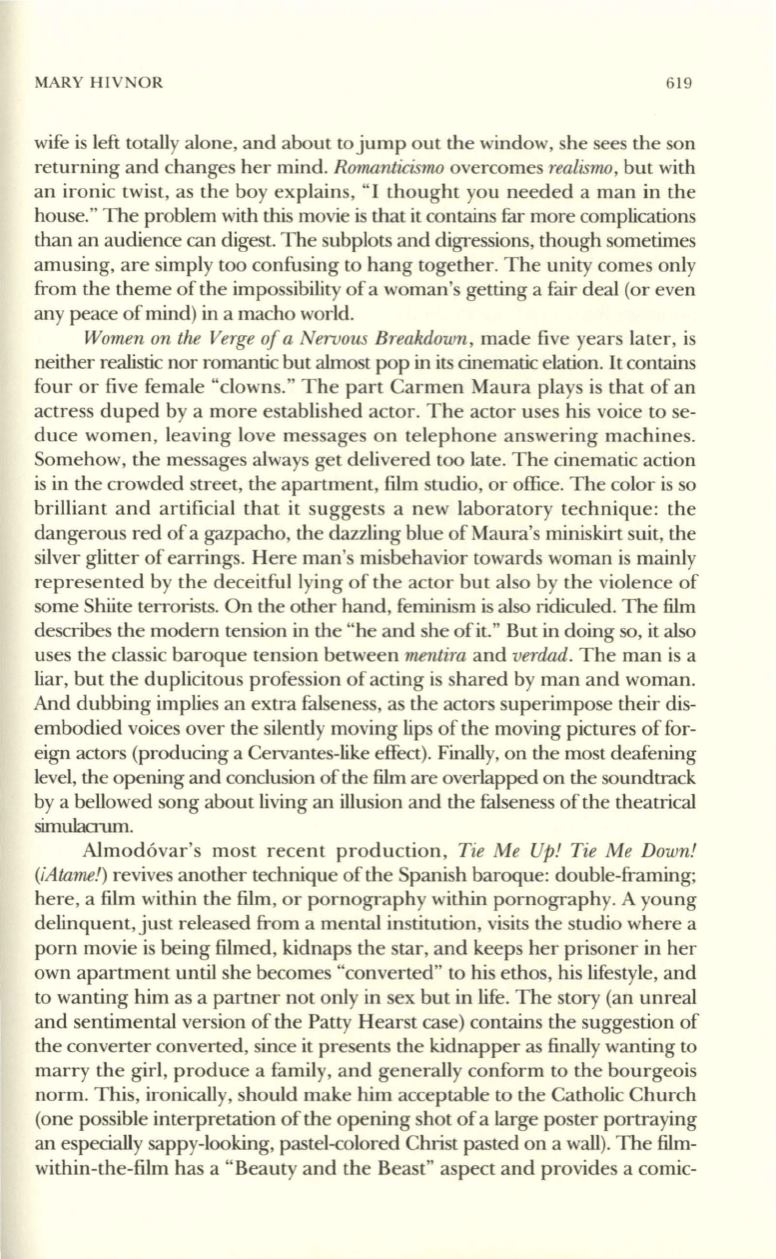
MARY HIVNOR
619
wife is left totally alone, and about to jump out the window, she sees the son
returning and changes her mind.
Romanticismo
overcomes
reaiismo,
but with
an ironic twist, as the boy explains, "I thought you needed a man in the
house." The problem with this movie is that it contains far more complications
than an audience can digest. The subplots and digressions, though sometimes
amusing, are simply too confusing to hang together. The unity comes only
from the theme of the impossibility ofa woman's getting a fair deal (or even
any peace of mind) in a macho world.
Women on the Verge of a Neroous Breakdown,
made five years later, is
neither realistic nor romantic but almost pop in its cinematic elation.
It
contains
four or five female "clowns." The part Carmen Maura plays is that of an
actress duped by a more established actor. The actor uses his voice to se–
duce women, leaving love messages on telephone answering machines.
Somehow, the messages always get delivered too late. The cinematic action
is in the crowded street, the apartment, film studio, or office. The color is so
brilliant and artificial that it suggests a new laboratory technique: the
dangerous red of a gazpacho, the dazzling blue ofMaura's miniskirt suit, the
silver glitter of earrings. Here man's misbehavior towards woman is mainly
represented by the deceitful lying of the actor but also by the violence of
some Shiite terrorists. On the other hand, feminism is also ridiculed. The film
describes the modern tension in the "he and she of it." But in doing so, it also
uses the classic baroque tension between
mentira
and
verdad.
The man is a
liar, but the duplicitous profession of acting is shared by man and woman.
And dubbing implies an extra falseness, as the actors superimpose their dis–
embodied voices over the silently moving lips of the moving pictures of for–
eign actors (producing a Cervantes-like effect). Finally, on the most deafening
level, the opening and conclusion of the film are overlapped on the soundtrack
by a bellowed song about living an illusion and the falseness of the theatrical
simulacrum.
Almodovar's most recent production,
Tie Me UP! Tie Me Down!
(IAtame.')
revives another technique of the Spanish baroque: double-framing;
here, a film within the film, or pornography within pornography. A young
delinquent, just released from a mental institution, visits the studio where a
porn movie is being filmed, kidnaps the star, and keeps her prisoner in her
own apartment until she becomes "converted" to his ethos, his lifestyle, and
to wanting him as a partner not only in sex but in life. The story (an unreal
and sentimental version of the Patty Hearst case) contains the suggestion of
the converter converted, since it presents the kidnapper as finally wanting to
marry the girl, produce a family, and generally conform to the bourgeois
norm. This, ironically, should make him acceptable to the Catholic Church
(one possible interpretation of the opening shot of a large poster portraying
an especially sappy-looking, pastel-colored Christ pasted on a wall). The film–
within-the-film has a "Beauty and the Beast" aspect and provides a comic-


